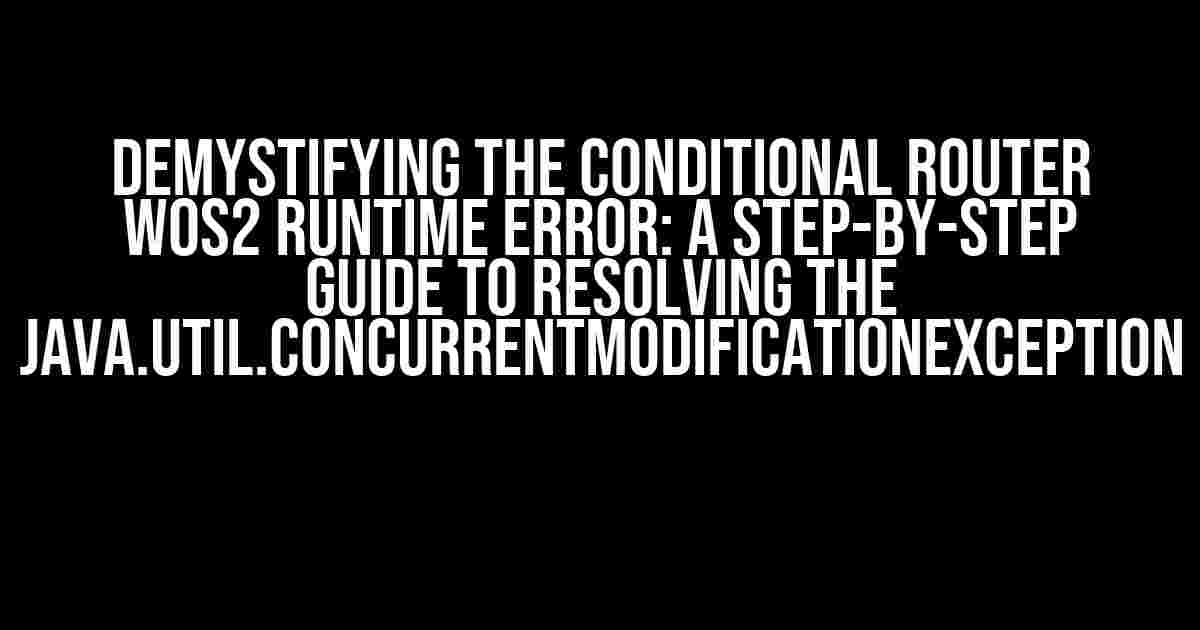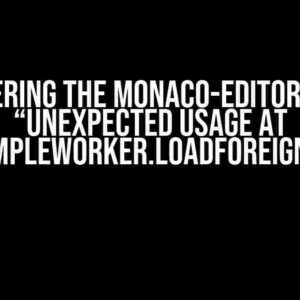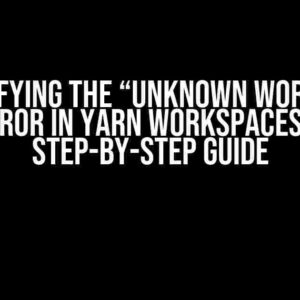If you’re reading this, chances are you’re stuck with a frustrating error message that’s got you stumped. Fear not, dear developer, for we’re about to embark on a journey to conquer the infamous Conditional Router WOS2 Runtime error, specifically the java.util.ConcurrentModificationException. By the end of this article, you’ll be well-equipped to tackle this pesky issue and get your application back on track.
What is the Conditional Router WOS2 Runtime Error?
The Conditional Router WOS2 Runtime error is a type of exception that occurs when the Conditional Router mediation flow in WSO2 EI (Enterprise Integrator) attempts to mediate a message. This error is often accompanied by the java.util.ConcurrentModificationException, which indicates that the error is related to concurrent modifications of a collection.
Causes of the Error
-
Concurrent modifications of a collection: This is the most common cause of the error. When multiple threads attempt to modify a collection simultaneously, it can lead to the ConcurrentModificationException.
-
Incorrect configuration of the Conditional Router: A misconfigured Conditional Router can cause the error to occur.
-
Corrupted or malformed messages: If the messages being processed by the Conditional Router are corrupted or malformed, it can lead to the error.
-
Resource constraints: Inadequate system resources, such as insufficient memory or CPU, can cause the error to occur.
Resolving the Conditional Router WOS2 Runtime Error
Now that we’ve identified the causes of the error, let’s dive into the step-by-step process of resolving the Conditional Router WOS2 Runtime error.
Step 1: Review and Refine the Conditional Router Configuration
Begin by reviewing the configuration of your Conditional Router. Ensure that it is correctly configured and that all variables and conditions are properly defined.
<conditionalRouter>
<element>
<condition>
<equal>
<variable>uri.var:uri</variable>
<value>/services/echo</value>
</equal>
</condition>
<target>
<endpoint>
<http>
<uri-template>http://localhost:9090/services/echo</uri-template>
</http>
</endpoint>
</target>
</element>
</conditionalRouter>
In the above example, ensure that the `uri.var:uri` variable is correctly defined and that the `condition` and `target` elements are properly configured.
Step 2: Check for Concurrent Modifications of Collections
Next, review your code to identify any instances of concurrent modifications of collections. Ensure that you’re using thread-safe collections or locking mechanisms to prevent concurrent modifications.
<synchronized>(collection) {
Iterator<?> iterator = collection.iterator();
while (iterator.hasNext()) {
Object element = iterator.next();
// Process the element
}
}</synchronized>
In the above example, we’re using a synchronized block to ensure that the collection is not modified concurrently.
Step 3: Verify Message Integrity
Verify that the messages being processed by the Conditional Router are valid and well-formed. Check for any syntax errors or corruption in the messages.
| Message Attribute | Valid Value |
|---|---|
| Content-Type | application/json |
| Message Body | { “key”: “value” } |
In the above example, we’re verifying that the message has a valid Content-Type and a well-formed message body.
Step 4: Optimize System Resources
Ensure that your system has sufficient resources to process the messages. Check for any resource constraints, such as insufficient memory or CPU, and optimize your system accordingly.
-
Monitor system resources: Use tools like top, htop, or Task Manager to monitor system resource usage.
-
Optimize JVM settings: Adjust JVM settings, such as heap size and garbage collection, to optimize performance.
-
Scale horizontally: Scale your system horizontally by adding more nodes or instances to distribute the load.
Conclusion
In conclusion, the Conditional Router WOS2 Runtime error, specifically the java.util.ConcurrentModificationException, can be resolved by following a series of steps. By reviewing and refining the Conditional Router configuration, checking for concurrent modifications of collections, verifying message integrity, and optimizing system resources, you can resolve this error and ensure the smooth operation of your application.
Additional Tips and Best Practices
-
Use thread-safe collections and locking mechanisms to prevent concurrent modifications.
-
Implement error handling and logging mechanisms to detect and diagnose errors.
-
Monitor system resources and optimize performance regularly.
-
Test and validate your Conditional Router configuration thoroughly.
By following these tips and best practices, you can avoid common pitfalls and ensure the reliability and efficiency of your Conditional Router and WSO2 EI-based application.
Final Words
Resolving the Conditional Router WOS2 Runtime error requires patience, persistence, and a systematic approach. By breaking down the error into its constituent parts and addressing each cause individually, you can overcome this error and get your application back on track. Remember to stay vigilant, monitor your system regularly, and optimize performance to ensure the smooth operation of your Conditional Router and WSO2 EI-based application.
Frequently Asked Questions
Having trouble with Conditional Router Wos2 Runtime error? Don’t worry, we’ve got you covered!
What is a Conditional Router Wos2 Runtime error, anyway?
A Conditional Router Wos2 Runtime error occurs when there’s an issue with the execution of a conditional routing policy in an integration flow. This error is usually caused by a concurrency issue, where multiple threads are trying to access and modify the same data simultaneously, resulting in a java.util.ConcurrentModificationException.
What causes a Conditional Router Wos2 Runtime error?
The main culprit behind this error is the java.util.ConcurrentModificationException. This exception is thrown when a thread tries to modify a collection (like an array or list) while another thread is iterating over it. In the context of Conditional Router Wos2, this can happen when multiple messages are being processed concurrently, and the router is trying to modify the message payload or headers.
How do I resolve a Conditional Router Wos2 Runtime error?
To resolve this error, you can try synchronizing the access to the shared data using locks or atomic variables. You can also consider using a thread-safe data structure, like a CopyOnWriteArrayList, to avoid concurrent modification issues. Additionally, review your integration flow and conditional routing policy to ensure that they are designed to handle concurrent message processing.
Can I prevent Conditional Router Wos2 Runtime errors from happening in the first place?
Yes, you can take preventative measures to reduce the likelihood of this error occurring. For instance, you can design your integration flow to process messages sequentially, rather than concurrently. You can also implement error handling and retry mechanisms to handle any concurrency issues that may arise.
What are some best practices for using Conditional Router Wos2 to avoid runtime errors?
To avoid runtime errors, make sure to follow best practices such as using thread-safe data structures, synchronizing access to shared data, and designing your integration flow to handle concurrency issues. Additionally, thoroughly test your conditional routing policy and integration flow to ensure they can handle different message scenarios and concurrency conditions.



